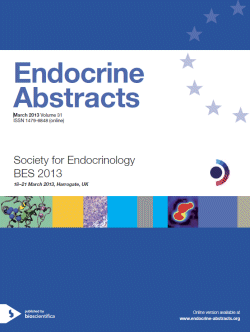Searchable abstracts of presentations at key conferences in endocrinology
Symposia
Non functioning pituitary tumours (Supported by <emphasis role="italic">Endocrine-Related Cancer</emphasis> and the Pituitary Foundation)
ea0031s8.1 | Non functioning pituitary tumours (Supported by <emphasis role="italic">Endocrine-Related Cancer</emphasis> and the Pituitary Foundation) | SFEBES2013
Epidemiology and natural history of pituitary tumours
Non-functioning pituitary adenomas (NFAs) are benign pituitary neoplasms arising from the adenohypophyseal cells. They are not associated with clinical evidence of hormonal hypersecretion and have a prevalence of 22 cases/100 000 people. They are diagnosed more commonly in males (2/3 of the NFA cases) and based on a recent UK community-based cross-sectional study, the median age at their diagnosis is 52 years (males 51 and females 43). At presentation, the majority is macroade...
ea0031s8.3 | Non functioning pituitary tumours (Supported by <emphasis role="italic">Endocrine-Related Cancer</emphasis> and the Pituitary Foundation) | SFEBES2013
Pathological markers of aggressive pituitary tumour behaviour
Recent advances in molecular pathology have improved our knowledge on the pathogenesis of pituitary tumors, as well as on their growth potential, likelihood of recurrence, and prognosis. The development of reliable and prognostically informative methods of assessing tumor behavior is particularly important in pituitary tumors, where no precise correlation exists between morphology and clinical aggressiveness. Specific morphologic features (macroscopic invasion of the perisella...
ea0031s8.4 | Non functioning pituitary tumours (Supported by <emphasis role="italic">Endocrine-Related Cancer</emphasis> and the Pituitary Foundation) | SFEBES2013
Aggressive pituitary tumours and temozolomide treatment
Aggressive pituitary tumours are particularly challenging to clinicians in terms of diagnosis and treatment. They may first present as typical pituitary adenomas, with a delayed appearance of aggressive signs, or initially as aggressive tumours. Predicting pituitary tumour behaviour remains difficult: increased mitotic, Ki-67, and P53 indexes may be associated with tumour aggressiveness. True pituitary carcinomas are rare, representing about 0.2% of all pituitary tumours. The ...




